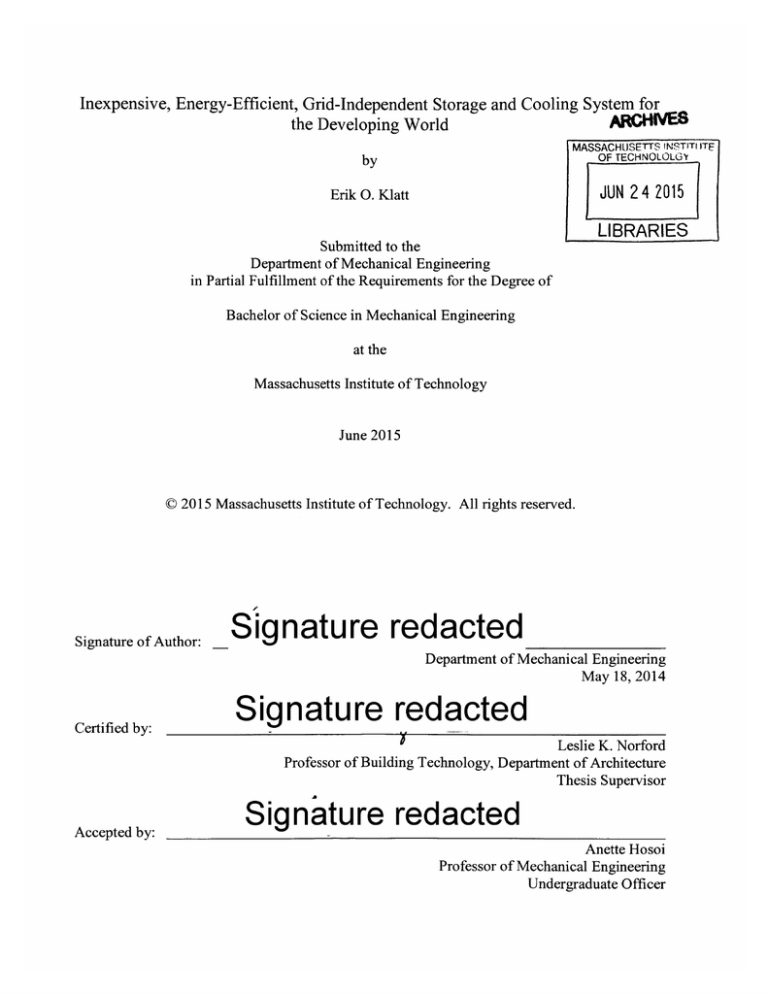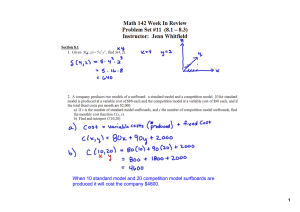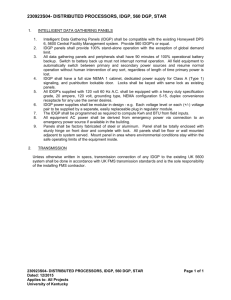
Inexpensive, Energy-Efficient, Grid-Independent Storage and Cooling System for
ARCHIVES
the Developing World
by
MASSACHUSETTS W7Tm TE
OF TECHNOLOLGY
Erik 0. Klatt
JUN 2 4 2015
LIBRARIES
Submitted to the
Department of Mechanical Engineering
in Partial Fulfillment of the Requirements for the Degree of
Bachelor of Science in Mechanical Engineering
at the
Massachusetts Institute of Technology
June 2015
C 2015 Massachusetts Institute of Technology. All rights reserved.
Signature of Author:
Signature redacted____
Department of Mechanical Engineering
May 18, 2014
Certified by:
Signature redacted
Leslie K. Norford
Professor of Building Technology, Department of Architecture
Thesis Supervisor
Accepted by:
Signature redacted
Anette Hosoi
Professor of Mechanical Engineering
Undergraduate Officer
Inexpensive, Energy-Efficient, Grid-Independent Storage and Cooling System for
the Developing World
by
Erik 0. Klatt
Submitted to the Department of Mechanical Engineering
on May 18, 2015 in Partial Fulfillment of the
Requirements for the Degree of
Bachelor of Science in Mechanical Engineering
ABSTRACT
Hunger and malnutrition can be significantly reduced in developing nations by improving the
farmer-to-consumer system. One important step in particular that can be improved is cold
storage at the local level. If small, rural farmers could have access to affordable and reliable
chilled storage, more produce would reach the consumer, and the farmer would see his income
increase.
A team of several people has been working to address this issue by developing a cold storage
system that is inexpensive, thermally efficient, and easy to assemble and maintain. Using
Polyurethane structure insulated panels, Cryogel ice balls, and a unique storage layout, the team
was able to design a prototype that met these criteria.
This thesis shows the author's research and design decisions, not the collective work of the entire
team.
Thesis Supervisor: Leslie K. Norford
Title: Professor of Building Technology, Department of Architecture
2
Table of Contents
Abstract
2
Table of Contents
3
List of Figures
4
List of Tables
6
1. Introduction
6
1.1. Food Grown in India
7
1.2. Electricity Grid Reliability
7
8
2. Research
2.1. Thermal Energy Storage
8
2.2. Insulation and Building Material
9
10
2.3. Existing Technology and Companies
11
3. Testing and Modelling
11
3.1. Door Test
12
4. Purchasing Decision
12
4.1. Criteria and Final Decision
5. Layout and Enhancements
14
5.1. Storage Bin Layout
14
5.2. Mylar Wrapping
16
6. Future Work
16
6.1. Assembly
16
6.2. Solar Power
16
17
7. Bibliography
3
List of Figures
Figure 1:
Cold storage capacity by state
6
Figure 2:
India's five power grid regions
8
Figure 3:
Door test
12
Figure 4:
Final, assembled product
14
Figure 5:
Insulated, locking panels
14
Figure 6:
Outside of cold room, inside storage bin set-up
15
Figure 7:
Solar radiation levels in India
16
4
List of Tables
TABLE 1:
Common fruits and vegetables, India's global rank and production size
7
TABLE 2:
India's projected power supply position
8
TABLE 3:
Thermal energy storage options
9
TABLE 4:
Various insulation material options
10
TABLE 5:
Potential companies
13
5
1
Introduction
About 805 million people, or 11.3 percent of the world's population, are undernourished [1].
This is not necessarily due to a lack of food, however. Oftentimes, good food spoils before
reaching the market, typically as a result of a lack in adequate cooled storage. In India
specifically, up to 18 percent of fruits and vegetables are wasted due to the absence of an
infrastructure that would otherwise support the farmer-consumer relationship [2]. Cold storage
is an important part of this infrastructure. See Figure 1 below for India's current cold storage
capacity. Note that this includes all cold storage, whether owned by retailers or individual
farmers.
NUMBERS ON THE MAP INDICATE
PRESENT CAPACITY (IN MILLION MT)
STATES
WITH ADEQUATE COLD
STORAGE FACILITIES
4
STATES THAT HAVE SOME BUT NEED
MORE COLD STORAGE FACILITIES
STATES NEEDING MORE COLD
STORAGE FACILITIES
Source
Dtrectorate
of Marketn
and Inspecton MiisrM
Figure 1: Cold storage capacity by state as of 2010, in millions of metric tons
6
If Aqpic lurt Gcivernmenl of
India
If local farmers in India had a means of effectively holding their crop, they would increase their
profits by selling more units.
1.1 Food Grown in India
India produces much of the world's food, and is the world's second largest producer of fruits and
vegetables [2]. See Table 1 for common fruits and vegetables and India's global ranking in
production [3].
Fruit/Vegetable
Bananas
Mangoes
Oranges
Potatoes
Tomatoes
Global Rank Production (metric tons)
27,575,000
1t
18,002,000
1st
4___
2n
6,426,200
45,343,600
18,227,000
2 nd
Table 1: Common fruits and vegetables, India's rank and production size for each
One small example of the economic benefit that would accompany increased cold storage is the
banana industry. While India produces roughly 28% of the world's bananas, these bananas make
up only 0.3% all internationally-traded bananas. If the cold chain infrastructure were sufficiently
upgraded, the number of containers of exported bananas could rise from 3,000 to 190,000,
providing an additional 95,000 jobs and benefiting about 35,000 smallholder farmers [4].
1.2 Electricity Grid Reliability
The power grid in India is insufficient for its needs. Only 52.5% of rural households have access
to electricity [5]. During blackouts, around 400 million Indians lose access to electricity [6].
This lack of power makes it difficult for small farms to make effective use of cold storage. They
need cold storage that can last through the not infrequent blackouts that plague India. See Figure
2 [7] for a breakup of India into its five power grid regions and Table 2 [5] for power
requirements versus power availability by region.
7
Peculiarities of Regional Grids in India
REGIONAL
cmc
GRI
1
&mbd-"'"4d -ft^w1***
S Rn
H'V"w''aern~Mnlnd
1 MV6M we"Ma MMO
F&
ftio Mu*
Snmd
fthhyftpsl 61
High
ruaiwm
APithwadbwseiod
planl
Monow
wsm
ydro
Figure 2: The five power grid regions in India, along with some facts
Region
Northern
Western
Southern
Eastern
North-Eastern
India Total
Requirement
(MU)
328,944
288,062
298,180
118,663
14,823
1,048,672
Energy [8]
Availability
(MU)
318,837
289,029
260,366
114,677
12,248
995,157
Surplus/
Deficit
-3.1%
+0.3%
-12.7%
-3.4%
-17.4%
-5.1%
Peak Power [8]
Demand
Supply
(MW)
(MW)
47,570
46,899
52,652
45,980
32,423
41,677
17,608
17,782
2,215
2,543
147,788
144,788
Surplus/
Deficit
-1.4%
+14.5%
-22.2%
+1.0%
-12.9%
-2.0%
Table 2: India's Projected Power Supply Position for FY2014-15
2
Research
2.1 Thermal Energy Storage
Because the electric grid in India is unreliable for 24 hours per day, there needs to be some way
to maintain cold temperatures independent of consistent power. In order to reduce the need to
draw from solar panels-or eliminate the need to use them whatsoever-the research team
working on this project decided to use thermal energy storage (TES). TES refers to energy
storage based on a temperature differential. Energy is transferred from an energy source to a
storage unit, where the energy can later be accessed. A hot water heater is a good example of
TES; energy from the power grid or another source is stored in the water until it is ready for use
[9].
8
We considered several options when looking for the appropriate medium in which to store our
thermal energy. Table 3 shows those options.
Medium
______
______
Initial Cost
Maintenance
(USD/ton)
__
_
_
Concrete
45 [10]
Low
Cryogel
Dirt
175 [12]
Essentially Free
Low
Low
Water
Essentially Free
Low
_
Energy Density
__
_
_
_
_
_
_
_
_
2122(J/kg*C) [11
3.35x106 (J/kg);
4190(J/kg*C) [11]
2100-2600 [11]
3.35x106 (J/kg);
4190(J/kg0 C) [11]
Table 3: Thermal energy storage options
The team decided to go with Cryogel ice balls. They are essentially four-inch diameter plastic
spheres filled with water which freezes and melts to store and release energy. Because of their
spherical shape, there is much more surface area exposed as compared to tubs of water, dirt, or
concrete, which drastically increases surface area. Compared to similar ice thermal storage
methods (e.g. tanks of ice, tubs of ice, etc.), Cryogel ice balls offer 1.5 to 3 times as much
surface area, resulting in over 24 ft2 of heat transfer surface area per ton-hour [13]. In
comparison, the surface area of ice-on-coil systems is only between 7.5 ft2 and 17 ft2 per tonhour [13]. This means that even though both water and Cryogel ice balls take advantage of their
phase change energy, the ice balls are more effective due to their greater surface area. Compared
to chilled-water systems (and by extension, chilled-dirt and chilled-concrete systems), use of
Cryogel ice balls can increase storage capacity by 4 to 5 times [12].
2.2 Insulation and Building Material
This system must be able to keep heat out so that it can preserve a stable, cool environment. It
must do so at a low cost and despite inconsistent power from local power grids. Along with
thermal storage, good insulation is key to maintaining appropriate temperatures. There were
many options to consider in selecting insulation. Cost, load-carrying capability, robustness,
portability, and ease of assembly were considered. Table 4 is a modified Pugh chart that the
team used to compare various insulation material options with respect to the aforementioned
aspects. Plywood was taken as the baseline because it was in the middle of many categories, it's
a simple material, and it's very common, therefore easy to visualize in comparison.
9
Material
Load
Robust
Portable
Ease
Plus Means
Handles
Larger
Load
More
Robust
More
Portable
Easier to
Assemble
Aluminum
[14]
Brick [14]
Concrete
[15]
S
Cost
$$
R-Value
(ft2-F-hr/Btu-in)
0.6
0.2
$$
0.08
$$0.9
Drywal
Plywood
[14]
Polyurethane
S
S
S
S
Rigid Panels
S
S
S
S
[14]
Steel [14]
Stone [16]
VacuumInsulated
Panels [171
$
1.25
6.25
$$$
0.6
$$
2.5-3.7
$$$$
30-50
Table 4: Various insulation material options
A lot of aluminum would have to be used to make the box strong enough, which would drive up
the price as well as decrease its portability and ease of assembly. While brick and concrete are
sturdy, moderately-priced materials, it would take considerable time to build the box, after which
it would be very difficult to transport. The R-values are not very high either. Drywall doesn't
have much going for it other than a moderate R-value. Plywood and polyurethane rigid panels
are similar except for the higher R-value of the latter, albeit at a higher cost. Steel is strong, but
too expensive, especially given the fact that insulation would need to be added. Stone has a
moderate R-value, but it may be the least portable option, as well as the most difficult to
assemble. While vacuum-insulated panels have the highest R-values by far, they are too
expensive for rural farmers.
While aluminum, plywood, or steel could have been used along with some sort of foam or
batting insulation, the team felt that using polyurethane rigid panels, combining insulation with
structural support, would increase ease of assembly and decrease short- and long-term
maintenance costs. Another benefit of using polyurethane rigid panels is that they can be
ordered for particularly-dimensioned rooms. They would come ready-to-assemble, and the
panels would interlock with each other. This is shown in more detail in section 4.1.
10
2.3 Existing Technology and Companies
There are similar products/companies in the market already. One such company, Natural
Vegetables & Fruits Storage Pvt. Ltd., offers food storage in large, warehouse-like facilities.
They mainly deal in long-term storage up to two years. They offer temperature and humidity
control as well as the ability to manage the concentration of gases. Their unique method of
blending gases enables them to control the ripening cycle of stored products. They offer to build
these large facilities for its clients, who are likely retailers or very wealthy farmers [18].
Another similar company is International Coil Ltd. They feature warehouses with separate
rooms for various foods that require different temperatures and humidities. Their typical
installation is 4,000 metric tons, although they offer as small as 500 metric tons and as large as
40,000 metric tons [19].
These are just two of many companies that deal in large, cold storage technology; however, they
do not target the consumer group made up of poor, small farmers. The team hopes to help fill
this gap in the industry.
3
Testing and Modelling
3.1 Door Test
A very rough door test was conducted during a senior mechanical engineering class at MIT,
2.009: Product Engineering Processes. While the test was very simple and limited, it did point
the team in the right direction for door selection. The general idea was rudimentary but
effective: set cups of ice inside different boxes, and after a period of time take out the cups and
compare the amounts of water that melted. The set-up was simple: five 36"x36"x36" cardboard
boxes, sealed with tape, with different-styled doors cut into one side. One box was the control,
with no door. One box's door opened from the top. Another box had a sideways-swinging door
on the side. Another had an upwards-swinging door on the side. A fourth had a sliding side
door. The final and most complicated box had a swinging door with plastic strips on the inside
so that when the door was opened, there was still a layer of plastic. Figure 3 shows the box setup.
A team of four people opened and closed the four doors simultaneously, once every minute for
30 minutes. At the end of the half hour, the cups were taken out of the boxes and the water was
measured visually. The control box hardly had any water at all, meaning that almost no ice had
melted. The plastic-strip box had the second lowest amount of water. The other three boxes had
almost half of the ice melt during the test.
While this test may be very simple, we were able to conclude that for a prototype, it would make
sense to have plastic strips hanging on the inside of the door.
11
Figure 3: Five boxes set up for testing
4
Purchasing Decision
4.1 Criteria and Final Decision
As this product intends to work on a smaller scale than a warehouse, smaller options were
preferred. After extensive research into companies that sold either already-assembled storage
systems or insulation panels that could easily be assembled into a storage system, the field was
narrowed down to several companies based on the following criteria: first, established shipping
lanes with India; second, low minimum order requirements; and third, price. See Table 5 for
details.
12
Company
China Construction Ltd.
Lareitin
T Minimnnm Order of Panels
I
Cost (USD/m2)
Dinghao
Shanghai Soovee
Trading Co., Ltd.
Shanghai Xinlong
Fireproofing Materials
Co., Ltd.
Hebei Guanhong
Trading Co., Ltd.
Zhejiang Terasum Air
Duct Co., Ltd.
Guangzhou Koller
Refrigeration
Equipment Co., Ltd.
Table 5: Potential companies from which to buy polyurethane structural insulated panels
The final set of companies happened to all be from China, which worked well because China and
India have good shipping lanes connecting them. Based on the minimum order, only two
companies offered a lucrative deal: China Construction Ltd. and Guangzhou Koller Refrigeration
Equipment Co., Ltd. Note that one piece is larger than one square meter. One set is defined as
the number of panels needed to build one storage room, which is exactly what was needed. It
was then decided to go with Koller, as they offered a lower price. The reason some prices are so
low per square meter is that the minimum order is very high. The prototype being built is
estimated to have a surface area of less than 60 square meters, so buying a bulk order would not
be cost-effective.
The set bought from Koller consists of 59m 2 of 0.110 m-thick polyurethane structural insulated
panels. It comes with a hinged door, 1.800 m tall, 0.800 m wide, and 0.110 m thick. The
dimensions of the room are 4 m long, 3 m wide, and 2.5 m high. This gives an internal storage
capacity of 30m2 . See Figures 4 and 5.
13
Figure 4: The final, assembled product
Figure 5: On the left are the structure insulated panels. On the right is an example of the locking mechanism that
securely connects the panels.
5
Layout and Enhancements
5.1 Storage Bin Layout
It is important to have an estimate of the volume available for food storage. To do so first
requires a blueprint for food storage bins. See Figure 6 for a visualization of this setup.
14
0
Figure 6: On the left is an artist's rendition of the outside of the cooled storage room. On the right is an artist's rendition
of the interior storage bin set-up. This layout makes efficient use of the room, maximizing storage space and minimizing
empty space, %hile still allowing full access to each storage bin. The gray panels are interior insulation panels, and the
yellow panels are hanging plastic strips.
This layout of storage bins is an optimization of maximum storage volume, reduced air
circulation, and ease of human movement. By splitting the room into two sections with insulated
panels, air leakage through the open door is reduced. One side can be accessed, while the other
side is left relatively untouched. Plastic strips hanging at the entrances of these two sections
further limit air flow. Lining the outer walls and inner panels with bins maximizes storage
volume, while providing the user with two walkways with access to all of the bins.
Using five (only three are shown in the illustration for good visualization) layers of small storage
bins has several purposes. It is economical, because when fruits and vegetables are stored in
very large (in excess of one cubic meter) bins, the produce on the bottom gets crushed by the
weight of the produce on top, leading to bruising and rotting, unsellable crops, and lower profits
for the farmer. It is ergonomical, as workers are dealing with relatively light loads to carry. It is
space-effective, for if larger bins were used, farmers would not be able to lift them up to a high
shelf, and the top third (approximately) of the room would be wasted space that would still need
to be cooled. Finally, it accommodates the bin size that is already in common use on rural farms
in India. In case of a shortage of bins, milk crates or other reusable containers will suffice.
After establishing the storage bin blueprint, the total storage volume can be estimated. 100
storage bins with dimensions of 0.5 m long, 0.4 m wide, and 0.3 m tall gives a total bin storage
area of 4.3 m3 . The produce geometry is estimated as spherical. The volume of randomlypacked spheres has a density limit of 63.4%, which gives a total volume of 2.73 m 3 taken up by
produce [20]. This equates to 9.1% of the total volume of the room. Given that the volume that
would be taken up if the entire room were randomly packed with spherical produce has an upper
bound of 63.4% of the total volume, or 19.02 m3 , this storage bin layout occupies 14.4% of the
usable space.
15
5.2 Mylar Wrapping
One way to increase the thermal insulation of the storage container is to wrap the outside in
aluminized Mylar. Mylar is extremely reflective, with an emissivity of 0.03. Mylar is also
relatively cheap-around $90.00 to wrap the container in 2 mm-thick sheets. Reflecting the rays
of the hot Indian sun will improve the efficiency of the system by approximately 50% based on
very rough calculations. Since it is so cheap, the team plans on buying the Mylar to test its effect
on the efficiency of our cooling system. Even if it turns out to be far less than an improvement
of 50%, an improvement will make a positive difference.
6
Future Work
6.1 Assembly
The next step in this project is to assemble the prototype. A working space has been rented; it is
large enough to comfortably assemble the cold-storage system, and it has adequate power for any
tests that need to be run.
6.2 Solar Power
Although it is currently beyond the scope of this project, the possibility of using solar panels to
provide additional power was discussed at length. This is something that will be looked into in
greater detail and in the near future as the prototype is tested. India receives a lot of sunlight, so
solar panels would be effective if it is decided that they are necessary. See Figure 7 for a map of
India and its solar resources [21]. The system would need about 6 m 2 of solar panels, based on
rough calculations [22]. Placed on the roof, these panels would provide power to the cooling
system. Battery storage has not yet been thoroughly researched, as the team wants to rely on the
Cryogel ice balls as much as possible. Batteries would be a last resort, and the team will make a
final decision on them after testing the prototype.
16
India
kwh I sq.m
4.4 - 5
5.2 - 6
6.2 - 6.6
TmINK-6OAX-OWER C OM
2
Figure 7: Levels of solar radiation across India, with purple being the highest and approaching 7 kWh/m and blue being the
2
lowest and approaching 4 kWh/m
17
7
Bibliography
[1]
"2015 World Hunger and Poverty Facts and Statistics," 2015. [Online]. [Accessed 04 05 2015].
[2] S. Narayanswami, "The Food Wastage & Cold Storage Infrastructure Relationship in India," Emerson
Climate Technologies.
[3]
FAO, "faostat3.fao.org," 2013. [Online]. [Accessed 05 2013].
[4] T. U. o. Nottingham, "Cold Chain Opportunity Assessments," United Technologies, [Online].
Available: http://naturalleader.com/programs/future-of-food/.
[5] "The Electricity Access Database," [Online]. Available: iea.org.
[6] A. C. Revkin, "Money for India's 'Ultra Mega' Coal Plants Approved," The New York Times, 2008.
[7] "Plug In India: Off-grid Solar Market in India Set to Take Off," 2014. [Online]. Available:
http://www.pluginindia.com/off-grid-solar-set-to-take-off.html.
[8] C. E. Authority, "Load Generation Balance Report 2014-15," 2014. [Online]. Available:
http://www.cea.nic.in/reports/yearly/lgbr-report.pdf.
[9] W. G. Bartley, "Thermal Ice Storage: Application & Design Guide," EVAPCO, INC., Taneytown,
Maryland, 2007.
[10] "Concrete Price Considerations- Cost of Concrete," [Online]. Available:
http://www.concretenetwork.com/concrete-prices.html.
[11] "Heat Storage in Materials," [Online]. Available: http://www.engineeringtoolbox.com/sensibleheat-storage-d_1217.html.
[12] "Cryogel Ice Ball - Thermal Energy Storage (TES)," Cryogel, 2011. [Online]. Available:
www.cryogel.com.
[13] "Cryogel: Ice Ball Thermal Storage," [Online]. Available: www.cryogel.com.
[14] "R-Value Table," Residential Shipping Container Primer, [Online]. Available:
http://www.residentialshippingcontainerprimer.com/R%20Value%2OTable. [Accessed 09 May
2015].
[15] R. A. Ristinen and J. J. Kraushaar, Energy and the Environment 2nd Edition, Hoboken, NJ: John Wiley
& Sons, Inc., 2006.
18
[16] "Buildings Energy Data Book," [Online]. Available: buildingsdatabook.eren.gov. [Accessed 09 May
2015].
[17] A. Binz and A. Moosmann, "Vacuum Insulation in the Building Sector: Systems and Applications,"
The IEA Energy in Buildings and Communities (EBC) Programme, 2005.
[18] Y. Dahiya, "Welcome to Natural Vegetables & Fruits Storage Pvt. Ltd.," Natural Vegetables & Fruits
Storage Pvt. Ltd., [Online]. Available: http://nvfl.in/.
[19] "Cold Storage, Freezer - Ice Plants," International Coil Ltd., 2013-2014. [Online]. Available: http://icltech.com/index.php?option=comcontent&view=article&id=7&ltemid=138.
[20] C. Song, P. Wang and H. A. Makse, "A Phase Diagram for Jammed Matter," Nature, Volume 453,
Issue 7195, pp 629-632, 2008.
[21] "Solar Power in India," [Online]. Available: http://www.think-solar-power.com/Solar-Power-nIndia.html.
[22] D. McKenzie, "Lights on Solar," 16 November 2013. [Online]. Available:
http://www.lightsonsolar.com/solar-basics-kw-and-kwh/.
[23] J. Milnes, "Ice Balls Save Data Centre Energy Costs," Regrigeration and Air Conditioning Magazine,
27 October 2010. [Online]. Available: http://www.racplus.com/news/-ice-balls-save-data-centreenergy-costs/8607432.article. [Accessed 10 May 2015].
19




